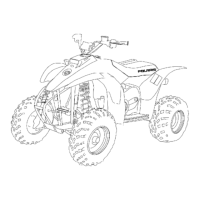THREE CYLINDER IGNITION (Con't.)
series
to
generate high voltage in secondary coils at the
timed
relation
to
ignite
for
each
cylinder
of
engine.
Per
revolution
of
the
rotor,
3 sparks
can
be
obtained
for
each
cylinder,
but
only
one spark
is
used
for
actual
ignition and the other
two
wasted. Such
an
ignition
system
as
ours
is
called
"Capacitor
Discharge Ignition
System"
(in abbreviation CDI system) .
Accordingly
this
CDI eliminates contact breakers and condensers in con-
ventional ways, in place
of
which
this
control
unit
named
"CDI
Unit"
embodying thristors, diodes, condensers, and
etc. therein.
2.2 Construction
of
Stator
The stator
has
six magnetic poles projecting in the inside
center which
are
of
laminated steel plates
with
plastic
powder coating.
Out
of
six,
four
pole cores are
directly
wound
coils and
two
leads
are
led
out
to
light
two
bulbs-
12V,
37.5W each. In this
case,
when one
bulb
is
gone, the
other
can
light normally.
The lighting
output
obtained also
can
be
used
for
one
bulb
only
of
75W
by
putting
those
two
leads together.
Next,
onto
the rest
of
the pole cores, the
same
number
of
exciting coils
which
work
as
the electrical power source
for
ignition are
put
and
fixed
by
fitting
plates.
Additionally,
this stator
is
also designed
to
mount
a coil
for
preventing inverse revolution
of
engine and
an
in-
dicator
for
the purpose
of
adjusting
ignition
timing
of
the
engine.
2.3 Construction
of
Rotor
The
rotor
has
such
an
outer
appearance
as
shown; a
boss
is
rivet-fixed
to
aluminum
diecast side plates,
on
the one
53

